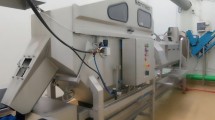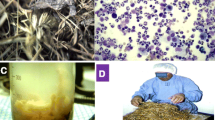Abstract
A respiratory syndrome very similar to extrinsic allergic alveolitis due to Penicillium verrucosum was recognized in 4 workers employed in a Gorgonzola cheese factory. A mycogen allergy to P. verrucosum, used as starter in the production, was demonstrated by positive sputum culture and detection of specific antibodies in the blood. Intense and prolonged exposure to inhalation of fungal spores could have lead to the development of this allergic response. The fact that 2 of the subjects are siblings seems to indicate host susceptibility or immunological constitution in the pathogenesis of the respiratory allergy.
Similar content being viewed by others
References
Smith JMB. Opportunistic mycoses of man and other animals. C.A.B. International Mycological Institute Kew 1989; 171-219.
Hoog GS de, Guarro J, eds. Atlas of clinical fungi. Centralbureau voor Schimmelcultures Baarn, Universitat Rovira Virgili Reus, 1995.
Segretain G. Description d’une nouvelle espèces de Penicillium: Penicillium marneffei, n.sp. Bull Soc Mycol de France 1959; 75: 412-416.
Drouhet E, Dupont B. Infection a Penicillium marneffei: mycose systémique a manifestations cutanées associée an SIDA. Journal de Mycologie Medicale 1995; 5 suppl I: 21-34.
Deng Z, Yun M, Ajello L. Human penicilliosis marneffei and its relation to the bamboo rat (Rhizomys pruinosus). J Med Vet Mycol 1986; 24: 383-389.
Frisvad JC, Filtenborg O. Terverticillate Penicillia: chemotaxonomy and mycotoxin production. Mycologia 1989; 81: 837-861.
Frisvad JC, Gravesen S. Penicillium and Aspergillus from danish homes and working places with indoor air problems: identification and mycotoxin determination. In: Samson RA et al., eds. Health implications of fungi in indoor environments; air quality monographs, Vol 2. Amsterdam: Elsevier, 1994: 281-290.
De Weck AL, Gutersohn J, Bütikofer E. La maladie des laveurs de fromages (Kasewascherkrankheit): une forme particulière du syndrome du poumon du fermier. Schweiz med Wschr 1969; 99: 872-876.
Molina Cl, Tourreau A, Aiache JM, Brun J, Jeanneret A, Roche G. Manifestations allergiques chez les fromagers. Etude clinique, épidémiologique et immunologique. Rev franç Allergol 1977; 17: 235-245.
Gari F, Lavaud F, Pinon JM. Asthine a Penicillium candidum avec présence de preécipitines chez un ouvrier fromager. Bull Soc Francaise Mycol Méd 1983; 12: 135-137.
Campell JA, Krida MJ, Treuhaft MW, Marx JJ, Roberts RC. Cheese worker’s hypersensitivity pneumonitis. Am Rev Respir Dis 1983; 127: 495-496.
Ouchterlony O. Diffusion-in-gel methods for immunological analysis. Progr Allergy 1957; 5: 1-78.
Evans EGV ed. Serology of fungal infection and farmer’s lung disease. A laboratory manual. Leeds University Printing Service. British Soc Mycopath 1976; 1-36.
Pitt JI. The genus Penicillium and its teleomorphic states Eupenicillium and Talaromyces. London: Academic Press, 1979.
Samson RA, Stolk AC, Hadlock R. Revision of the subsection Fasciculata of Penicillium and some allied species. Studies in Mycology, Baarn 1976; 11: 1-47.
Samson RA, Eckardt C, Orth R. The taxonomy of Penicillium species from fermented cheeses. Antonie van Leeuwenhoek 1977; 43: 341-350.
Samson RA, Hoekstra ES, Frisvad JC, Filtemborg O. Introduction to food-borne fungi. 5th Ed. Centraalbureau Voor Shimmelcultures Baarn, Delfi 1996; 1-322.
Stolk AC, Samson RA, Frisvad JC, Filtenborg O. The systematics of the Terverticillate Penicillia. In: Samson RA, Pitt JI eds. Modern concepts in Penicillium and Aspergillus classification. New York: Plenum Press, 1990: 121-137.
Hoog GS de, Smith MTH, Guého E. A revision of the genus Geotrichum and its teleomorphs. Studies in Mycology, Baarn 1986; 29: 1-131.
Domsch KH, Gams W, Anderson T H. Compendium of soil fungi. London: Academic Press, Vol. 1: 1-859; Vol. 2: 1-405.
Kurtzman CP, Fell JW. The yeast, a taxonomic study, 4th ed. Amsterdam: Elsevier, 1998.
Zycha H, Siepmann R, Linnemann G. Mucorales, eine Beschreibung aller Gattungen und Arten dieser Pilzgruppe. J Cramer, Lehre 1969.
Gregory PH. Microbiology of the atmosphere, 2nd ed. Leonard Hill Books, Aylesbury, Buchs. 1973.
Raper KB, Thom C. A manual of the Penicillia. Baltimore: Williams Wilkins Co. 1949.
Pitt JI, Cruickshank RH. Speciation and synonymy in Penicillium subgenus Penicillium. Towards a definitive taxonomy. In: Samson RA, Pitt JI eds. Modern concepts in Penicillium and Aspergillus classification. New York: Plenum Press, 1990: 103-119.
Horejši M, Sach J, Tomšikova, Mecl A. A syndrome resembling Farmer’s lung in workers inhaling spores of Aspergillus and Penicillia moulds. Thorax 1960; 15: 212-217.
Minning H, De Weck AL. Die ‚Kasewascherkrankheit‘. Immunologische und epidemiologische Studien. Schweiz med Wschr 1972; 102: 1205-1212.
Galland C, Reynaud C, De Haller R, Polla BS, Leuenberger P. Cheese-washer’s disease. A current stable form of extrinsic allergic alveolitis setting. Rev Mal Respir 1991: 8: 381-386.
Pitt JI, Hocking AD. Fungi and food spoilage. Sydney: Academic Press, 1985.
Lacey J. The aerobiology of conidial fungi. In: Cole JT, Kendrick B, eds. Biology of conidial fungi, Vol. 1. New York: Academic Press, 1981: 373-416.
Lacey J, Pepys J, Cross T. Actinomycete and fungus spores in air as respiratory allergens. In: Shapton DA, Board RG, eds. Safety in Microbiology. London, New York: Academic Press, 1972: 151-184.
Licorish K, Novey HS, Kozak P, Fairshter RD, Wilson AF. Role of Alternaria and Penicillium spores in the pathogenesis of asthma. Journal Allergy Clin Immunology 1985; 76: 819-825.
Crandall MS, Sieber WK. The National Institute for Occupational Safety and Health indoor environmental evaluation experience. Part one: building environmental evaluations. Appl Occup Environ Hyg 1996; 11: 533-539.
Malkin R, Martinez K, Marinkovich V, Wilcox T, Wall D, Biagini R. The relationship between symptoms and IgG and IgE antibodies in an office environment. Environmental research sect A 1998; 76: 85-93.
Allen DH, Basten A, Williams GV, Woolcock AJ. Familial hypersensivity pneumonitis. Am J Med 1975; 59: 505-514.
Purtilo DT, Brem J, Ceccaci L, Cassel C, Fitzpatrich AJ. A family study of pigeon breeders disease. J Pediatr 1975; 86: 569-571.
Author information
Authors and Affiliations
Rights and permissions
About this article
Cite this article
Guglielminetti, M., Valoti, E., Cassini, P. et al. Respiratory syndrome very similar to extrinsic allergic alveolitis due to Penicillium verrucosum in workers in a cheese factory. Mycopathologia 149, 123–129 (2001). https://doi.org/10.1023/A:1007293109657
Issue Date:
DOI: https://doi.org/10.1023/A:1007293109657




